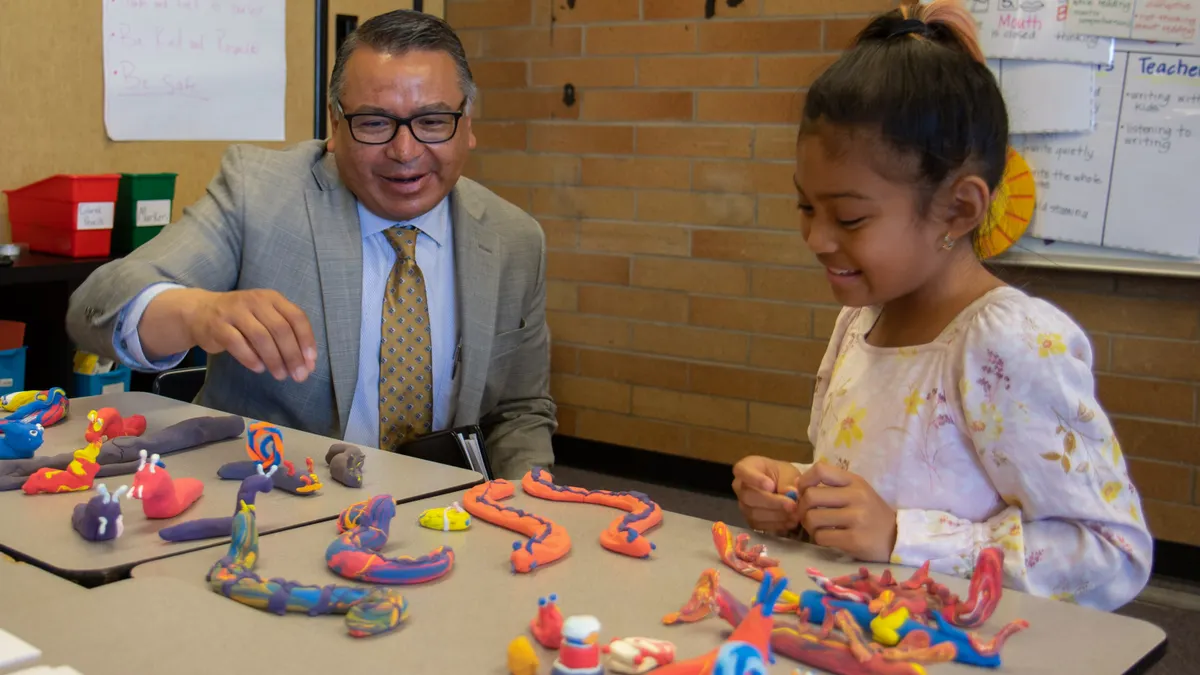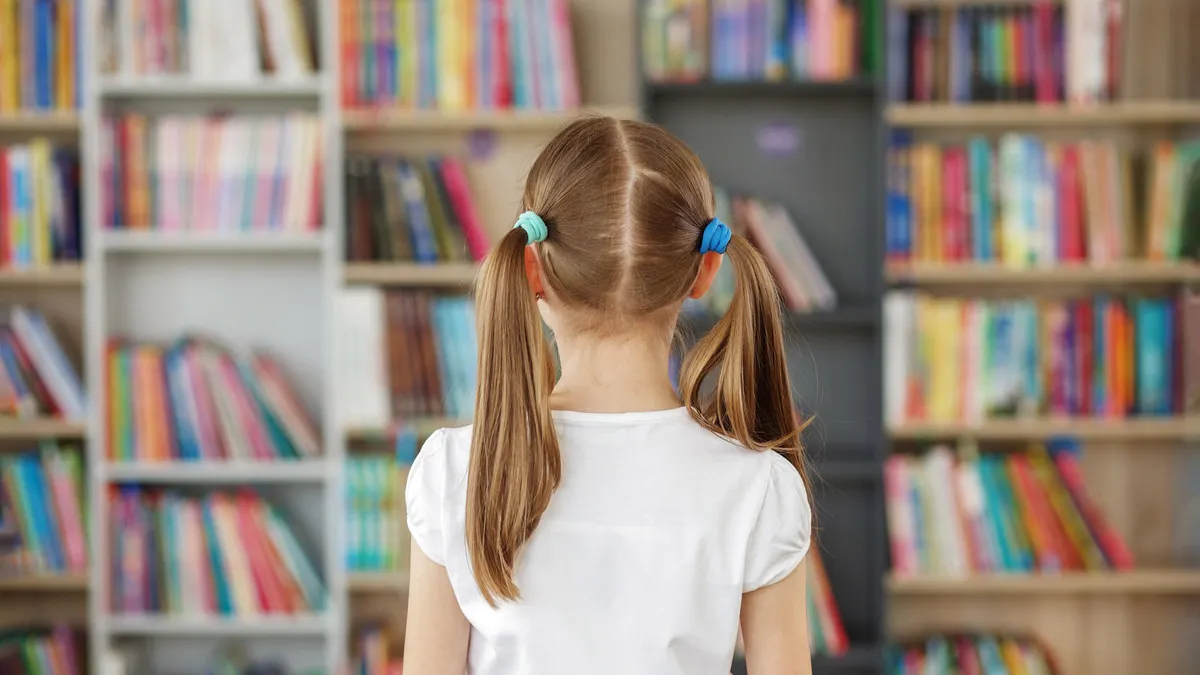Shirl Buss recalls 4th-graders finding their families' homes on an 8-foot model of San Rafael, California, and putting markers down to note the locations. Taking part in the Resilient by Design project, the students during the 2017-18 school year were tasked with creating proposals on how to mitigate rising sea levels in their city — but the prospect of their communities or homes impacted by floods was neither depressing nor daunting.
Instead, Buss notes, they were invested and excited.
“Students were fierce [and] innovative, and this whetted their appetite,” Buss — creative director of Y-PLAN, part of the University of California, Berkeley’s Center for Cities and Schools — told Education Dive. “They asked, ‘How old will we be when this happens? How high will the water be?’ Students were engaged and empowered.”
Teaching students about urban planning has long moved beyond using textbooks to show how cities are built on grids. Instead, students are asked to take authorship themselves, either by creating new potential spaces within their communities — similar to the Y-PLAN project — or asking them how those communities can be redesigned and having them craft proposals with that mission in mind.
All tap into project-based learning methods. Students work on a long term program together and often in assigned roles. The result is not just a working solution, but tools that teach them how to communicate and engage with others — skills they’ll need when they progress into the working world.
Community building
At the Center for Architecture in New York City, K-12 students undergo a design process, learning how buildings and spaces are built and created. They are then asked to tackle a real-world project in their own area, Catherine Teegarden, the center's education director, told Education Dive.
While, in most cases, their designs aren’t actually built, some students have seen their efforts turned into something tangible for their communities.
For example, as part of a semester-long, after-school partnership sponsored by New York City’s Department of Youth and Community Development, 5th-graders in Manhattan’s Chinatown neighborhood will be making seats for their community center entryway and rooftop playground, said Teegarden. Additionally, she said, 4th-graders at a public school in the Rockaway neighborhood of Queens are designing storage units for their after-school program.
We try to teach people how to read buildings for information, and just like learning to read words, once you have become literate in the language of architecture, you can’t really turn it off ... Instead, you start to notice new things, and it becomes a source of lifelong learning.

Catherine Teegarden
Director of Education, Center for Architecture
Even if projects are never built, though, the design process gives students some insight into how their own neighborhood is constructed. That’s one result from the work UrbanPlan for High Schools, part of the Urban Land Institute, does with high school students during their junior and senior years. Students redesign a fictional community, which helps them parse their own community as well.
“We ultimately hope that all students who participate in UrbanPlan will pay more attention to what changes are happening in their communities and play a larger role in shaping their communities in the future,” Sophie Lambert, senior director of UrbanPlan for High School, told Education Dive. “We hope they will be engaged and informed citizens who can make a difference where they live. If some of them become architects, planners or developers, then that is an added bonus.”
Shannon Corcoran sees how her students at Desert Vista High School in Phoenix — who have participated in the UrbanPlan in High Schools program since she took over the school’s economics program in 2008 — connect what they learn to how their own community was designed.
She often hears from students who have gone through the program and who tell her how they understand why a grocery store in their city had to be located on a main intersection, or why parking had to be designed a certain way, she told Education Dive.
“I also think they begin to look at their own communities with a different view and become more active citizens,” she said. “They also learn that planning is hard, and that tradeoffs have to be made, and that when planning you cannot make everyone happy.”
Gaining life skills
Tradeoffs are certainly part of the process of any group-based activity — a life skill that many students who go through urban planning activities and lessons develop. With UrbanPlan, for example, students learn how to work with a team, notes Lambert, as well as how to handle challenges on the fly. And with Y-PLAN, Buss notes, students develop resiliency, another crucial skill for any field.
Buss recalls when some San Rafael 4th-graders, while manning a booth at an event called the Flood Fair, were confronted by a local activist who asked them how their solutions to flooding, such as elevated pathways and floating buildings, would work when toilets didn’t flush.
“One student came back and showed her how you could use flood gates and other tools,” said Buss. “And while [the solution] wasn’t exactly correct, the activist was blown away by the student who believed in themselves.”
Wendy Holm has seen how her own AP Economics students at the Boston Latin School — which has worked with UrbanPlan since 2007 — develop the skills to cooperate, communicate and compromise, she told Education Dive. They spend about three and a half weeks every January and February working on their projects, and the program requires them to depend on each other to complete their work.
“Most students comment on how this group experience does not devolve into one or two people doing all the work, which is a welcome change to what can often happen in group projects in schools,” she said.
The Center for Architecture’s Teegarden even notes that urban planning can help students develop a new language and a new way of reading their own communities. They begin to understand how a building is designed, why a community was planned and “how it impacts their daily lives,” she said. Those tools can help students look beyond their own neighborhoods and at the world at large, taking that new skill with them wherever their lives may go next.
“We try to teach people how to read buildings for information, and just like learning to read words, once you have become literate in the language of architecture, you can’t really turn it off,” she said. “Instead, you start to notice new things, and it becomes a source of lifelong learning.”



















